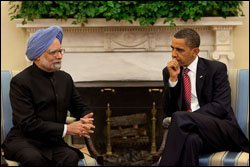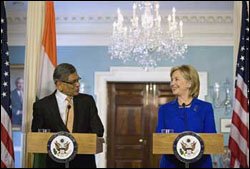Administration Initiatives Test Indo-U.S. Partnership
July 13, 2010
Neglect seems to be the operative word in President Obama’s India policy. After eight years of unprecedented cooperation and ever closer ties between the United States and India, the two countries have begun a slow drift apart. Although this is not the direction or outcome India desires, it well may be that the United States could stand to lose the most if the Indo-U.S. partnership falters.
July 13, 2010
Neglect seems to be the operative word in President Obama’s India policy. After eight years of unprecedented cooperation and ever closer ties between the United States and India, the two countries have begun a slow drift apart. Although this is not the direction or outcome India desires, it well may be that the United States could stand to lose the most if the Indo-U.S. partnership falters.
Today, the Congress Party government of Prime Minister Manmohan Singh appears to be in a standoff with the Obama Administration, not out of choice, but out of necessity and the White House has given very few indications that it intends to continue the partnership that has guided the relationship since the late 1990s. Council on Foreign Relations Fellow Evan A. Feigenbaum, a former Deputy Assistant Secretary of State for South Asia, cited a “a crisis of vision” as the principal cause of a “drift in the relationship.” Whatever its roots, a rift in relations would have profound consequences for America’s South Asia policy.
New Delhi Doubting White House Commitment to Nuke Deal
Many India-watchers believe that the Obama Administration’s reversal of the previous administration’s attitude toward arms control and the Non-Proliferation Treaty (NPT) is guiding the White House’s current India policy, even though then-Senator Obama had pledged broad support for the 2008 Indo-U.S. civilian nuclear fuel deal.  The deal marked a sea change in U.S. policy putting India’s democracy and solid track record of non-proliferation above formal arms control treaties signed by states with dubious records of abiding by international accords. The agreement was not without controversy, however, especially in India where a powerful Communist Party nearly scuppered the deal, claiming it would result in an over-reliance on the United States for the country’s energy needs.
The deal marked a sea change in U.S. policy putting India’s democracy and solid track record of non-proliferation above formal arms control treaties signed by states with dubious records of abiding by international accords. The agreement was not without controversy, however, especially in India where a powerful Communist Party nearly scuppered the deal, claiming it would result in an over-reliance on the United States for the country’s energy needs.
Under the terms of the agreement, the United States will sell nuclear fuel, technology and reactors to India for peaceful energy generation use. In exchange, India will allow its 14 civilian nuclear facilities to be inspected by international watch dog groups, but would allow Delhi to maintain its eight military reactors outside of scrutiny.
The Obama Administration’s goal of downsizing America’s nuclear arsenal and freezing new nuclear projects has India doubting the partnership’s future. Prof. M.D. Nalapat, Director of the Department of Geopolitics at Manipal University in southern India and a popular political commentator, said that the Indian leadership is prepared to move forward with the deal, but has grown wary of the White House’s start-stop approach. He believes that “every section of [the Indian] leadership regards the acceptance of India’s ‘high-caste’ status [as a nuclear power] by other countries as a litmus test of their sincerity towards India…which is why the palpable hostility of President Obama to India being accepted as a full member of the club – the way smaller countries such as France and the U.K. are – has created unease and some anger within the Indian ‘Beltway.'” Nalapat’s sentiments, it would seem, mirror those of the Indian government.
After meeting with President Obama in Washington on November 22, 2009, Prime Minister Singh expressed his “sincere hope…[to] persuade the U.S. Administration to be more liberal when it comes to transfer of dual-use technologies to [India],” asserting that “these restrictions make no sense…now that [India and the U.S.] are strategic partners.”
Indian leaders have repeatedly declared that under no circumstances will India forfeit its nuclear arsenal, but the White House continues to use safeguards and oversight as a sticking point, despite India’s solid record on non-proliferation. Nalapat sees no reason to doubt this record, and calls the White House’s desire “to use the agreement to get ‘carte blanche’ on the full range of Indian nuclear production facilities…unacceptable…[because] the fuel used in the reactors that have international collaboration would be used solely for civilian purposes, but the measures that are being urged on India have the objective of opening the entire program – both international and indigenous – to oversight and controls that would stifle research and the integrity of the deterrent.” Nevertheless, in an important step toward realizing the provisions of the deal, in March of this year both countries agreed upon the procedures for reprocessing U.S.-origin spent nuclear fuel under IAEA guidelines some six months ahead of schedule.
 Unassured, India has sought out other nuclear allies. Shortly after concluding the 2008 agreement with the U.S., India inked a deal for Russian supplies of uranium fuel that would continue even in the event that India tests a nuclear device. And on March 12, 2010, India signed a $7 billion deal for Russian military hardware, including an aircraft carrier, a fleet of MiG-29 fighters, defense and space technology, and at least 12 civilian nuclear reactors, after the White House spurned requests to sell India the decommissioned aircraft carrier USS Kitty Hawk.
Unassured, India has sought out other nuclear allies. Shortly after concluding the 2008 agreement with the U.S., India inked a deal for Russian supplies of uranium fuel that would continue even in the event that India tests a nuclear device. And on March 12, 2010, India signed a $7 billion deal for Russian military hardware, including an aircraft carrier, a fleet of MiG-29 fighters, defense and space technology, and at least 12 civilian nuclear reactors, after the White House spurned requests to sell India the decommissioned aircraft carrier USS Kitty Hawk.
The prospects for an Iran-Pakistan-India (IPI) gas pipeline lead most observers to believe that the Indian leadership is still concerned that if the 2008 nuclear fuel agreement falls apart, India will be left in the lurch. IPI would allow Iran to sell its natural gas to both Pakistan and India.
Originally conceived to send natural gas to solely to Pakistan, India joined the venture in 1999. In 2009, however, India withdrew from the project over pricing and security issues as well as the fact the U.S. nuclear deal would pave the way for increased domestic energy production but in March 2010 India called for a resumption of talks with Pakistan and Iran on the pipeline, a decision that could have far-reaching political consequences.
In January 2010, the Obama Administration failed to convince Pakistan to abandon the pipeline project despite promises of assistance for the construction of a liquefied natural gas terminal and importing electricity from Tajikistan through Afghanistan’s Wakhan Corridor.
Historically, India and Iran have enjoyed close ties due to their geographic proximity and shared regional interests. While India by no means desires a nuclear Iran, continued cooperation between the two countries hurts the American drive to isolate the Iranian regime over its pursuit of nuclear weapons.
Where Does India Fit in U.S. Embrace of Pakistan and China?
India has proven to be a valuable partner in the war against violent Islamist extremism, but the White House’s unwillingness to partner with India in fighting terror has forced New Delhi to seek out partnerships with other countries and strongly reconsider its role in Afghanistan. The Obama Administration has forged closer ties with the Pakistan’s quasi-independent Inter-Services Intelligence (ISI), the agency that nurtured the Taliban and has played a role in training terrorists and supporting their attacks against India, which has led to much apprehension and concern in New Delhi, where policy makers worry that India stands much to lose because of these policies. Feigenbaum noted that New Delhi views “Pakistan’s role as a central go-between in efforts to promote reconciliation with elements of the Taliban…as a fool’s errand.”
Moreover, the White House’s move to cooperate more closely with China has produced two seemingly contradictory responses from the Indian leadership. Predictably, this partnership has confused and angered Prime Minister Singh’s government. Feigenbaum said “Indians have become increasingly sensitive to suggestions that the United States looks to address global issues bilaterally with China, fearing that this will sideline New Delhi and work against Indian interests.” On the other hand, it has encouraged India to strengthen its ties to China, and work without the U.S. to resolve regional problems. This new paradigm was apparent at the December 2009 climate summit in Copenhagen. India opposed the proposed deal for several reasons, but the message was clear: India would not be perceived as moving in lockstep with the United States. Nalapat believes, like many other Indian commentators, that if the partnership “falls through because of the refusal of Washington to accept India as ‘high-caste,’ the way gets opened for Beijing to seek to work out an entente with Delhi.”
Indeed, there are signs that Indian relations with long-time enemy China are improving even in an environment of anger and confusion in New Delhi over the White House’s own diplomatic overtures to Beijing which may very well prove to be a hollow attempt to gain China’s support at the U.N. Security Council against Iran. The entire affair has seemingly emboldened China to seek out its own bilateral nuclear agreement with Pakistan, without many of the hard-fought for safeguards and guidelines provided for in the Indo-U.S. nuclear deal.
The “Af-Pak” Policy’s Unintended Effects
One of the greatest obstacles to a healthy American partnership with India is the White House’s so-called “Af-Pak” policy. Unfortunately, the Obama Administration has failed to demonstrate that commitment to a successful prosecution of the war in Afghanistan means just as much to India’s security interests as it does to America’s, despite repeated overtures from the Indian government.
India maintains one of the largest civilian contingents in Afghanistan, and they have been the frequent targets of both the Taliban and Pakistani insurgents operating in Afghanistan. India has assisted the U.S. and the Northern Alliance in the past, which the Taliban has used as a call to arms against India. Pakistan opposes India’s increasing influence in Afghanistan, which it considers to be within its exclusive sphere of influence. The unusually close ties between the Pakistani security services and the U.S. Government are fraught with danger, because, as Nalapat noted, the ISI has a long history of supporting and assisting “religious fanatics,” dating to the liberation struggle in Afghanistan during the 1980s.
India stands to lose the most over a flagging U.S. war effort in Afghanistan. To its credit, the White House has recently attempted to assuage these concerns, revealed most notably in a June 1 speech by William J. Burns, State Department Undersecretary for Political Affairs: “Some in India do worry today that the United States seeks to ‘re-hyphenate’ relations with India…that we see India mainly through the prism of preoccupations in Afghanistan and Pakistan…that we won’t push Pakistan hard enough on terrorists who kill and threaten Indians…that we will hurry toward the exit in Afghanistan and leave India holding the strategic pieces.” Most commentators believe that these concerns can be partially overcome by pressuring Pakistan to allow the U.S. to fight the Taliban and al-Qaeda more aggressively in the border regions. But Nalapat isn’t so hopeful, and believes that India has to prepare for an inevitable U.S. withdrawal, noting glumly that “a strategy that relies on the arsonist to act as the principal firefighter is doomed to fail.”
Avoiding a Piecemeal Approach to Repairing Relations
Over the last month, several positive developments have made observers hopeful that the listing ship of the Indo-U.S. partnership can be righted. President Obama plans to visit India in November, coming on the heels of the first-ever Cabinet-level Strategic Dialogue between Secretary of State Hillary Clinton and Indian Foreign Minister S.M. Krishna which took place June 3-4, covering America’s and India’s joint commitment to Afghanistan, the nuclear fuel agreement, and fighting terrorism. Multiple challenges remain, however, and it will be interesting to see on what issues President Obama decides to devote his time with Prime Minister Singh. One gauge for success is the nuclear issue, and it seems that both sides are moving closer to common ground. Gaining India’s trust and cooperation requires reengaging India over big points, demonstrating that the White House has some sort of comprehensive strategy for the region. A piecemeal approach would serve only to further frustrate India and endanger the close between these two natural partners.
James Colbert is Policy Director and Jacob Levkowicz is a Research Associate at JINSA.